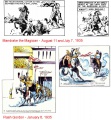Land of the Fakirs: Difference between revisions
(→Sweeping: corrected spelling) |
|||
| Line 91: | Line 91: | ||
=== [[Image:mini_turkey.gif]] Turkey === | === [[Image:mini_turkey.gif]] Turkey === | ||
*"Hindistanda", [[1001 Roman - Özel Sayı 1|''1001 Roman - Özel Sayı'' #1]] (1940) | *"Hindistanda", [[1001 Roman - Özel Sayı 1|''1001 Roman - Özel Sayı'' #1]] (1940) | ||
=== [[Image:mini_uk.gif]] United Kingdom === | |||
*"Land of the Fakirs", [[The Hidden Kingdom of Murderers: Sundays 1935–1937|Sundays 1935–1937]] (2016) | |||
=== [[Image:mini_usa.gif]] USA === | === [[Image:mini_usa.gif]] USA === | ||
Revision as of 15:09, 1 May 2016
| Land of the Fakirs | |

| |
| Start date: | June 2, 1935 |
|---|---|
| End date: | October 6, 1935 |
| # of strips: | 19 (19 weeks) |
| Writer: | Lee Falk |
| Artist: | Phil Davis |
| Preceded by: | "The Hidden Kingdom of Murderers" |
| Followed by: | "Land of the Little People" |
"Land of the Fakirs" is the 2nd Mandrake Sunday story. The story was written by Lee Falk and drawn by Phil Davis.
Plot Summary
Rajah Indus tried to capture Jehol Kahn's kingdom by kidnaped his beautiful daughter, Jana. Placed in his harem he wanted to force her to marry him. Capitan Jorga, the sweetheart of Jana, attemts to rescue her but fails. Then Mandrake shows up. At the end our friends manage to escape on a flying carpet (!). Jehol Kahn said his daughter Jana could not marry an ordinary commoner as Jorga. He said riches was more importaint than love, and Mandrake decides to teach him a lesson.
Mandrake made a trick, every thing Jehol Kahn touched turns into gold, even the water. Hours later Jehol Kahn found that he could not eat or drink gold. He learned his lesson and gave Jana his blessing for the marriage with Jorga.
Appearances
Recurring characters
One-time characters
- Jehol Kahn.
- Jana, daughter of Jehol Khan.
- Jorga, Captain and in love with Jana.
- Indus, Rajah of Lapore.
- Dupo, a fakire in Lapore.
- Melior, a girl in the harem of Rajah Indus.
Locations
- India
- Lapore, walled city of Rajah Indus.
Behind the scenes
- The title for the story taken from the strip of May 26th, 1935 (Next week: Mandrake in the Land of Fakirs).
Swiping
It is not an uncommon practice amongst comic strip and comic book artists to "borrow" (swipe) layouts and drawing styles from other artists. In an interview published in King Comic Heroes (James Van Hise, Pioneer Books, 1988), Lee Falk tells an amusing anecdote from the early days of his Mandrake strip:
"When I was working with Phil Davis doing layouts very early in the game, we had a Sunday page which had some rearing horses. Now these are illustrative artists and they use photo references and whole files of other artists' material. When I indicated a rifle or a gun or a tank, he had a model or something to copy from. They didn't copy it -- they used the file to get something for a model and they sketched from it. They didn't trace it or anything like that. They had to have a model just like they'd have a model for a woman. At that very moment, in I think it was Flash Gordon, they had some rearing horses. We used that as inspiration, but we didn't copy it. About a year later I moved to New York, and I went up and I had dinner with Alex Raymond up in Stamford where I'd moved to in Connecticut and he was showing me through his studio in his beautiful house and there on his drawing board was the Flash Gordon he was working on and next to it was the Sunday page of Mandrake with the rearing horses -- he was using it as a model. I said, 'But Alex, we copied that from you!' He said "Oh, for Christ's sake!' He'd forgotten."
Reprints
This story has been published in the following publications:
 Brazil
Brazil
- "No País dos Faquíres", Mandrake (1974)
 France
France
- "Le royaume des bandits", Collection merveilleuse #3 (1939)
- "Le royaume des bandits", Aventures et Mystère #38 (1948)
- "Le royaume des bandits", Mandrake roi de la magie #2 (1964)
- "Le royaume des bandits", Mandrake roi de la magie #23 (1967)
 Italy
Italy
- "Mandrake nel paese dei fachiri", L'Audace (1935-1936)
- "Mandrake il magnetizzatore", Gli Albi dei tre porcellini #15 (1937)
- "Mandrake il magnetizzatore", Albi d'Oro #57 (1947)
- "Mandrake contro il rajah di Lagore", Mandrake (1949)
- "Mandrake contro il rajah di Lagore", Enciclopedia dei fumetti #3 (1970)
- "Il paese dei fachiri", Mandrake (Garzanti) (1972)
- "Nel paese dei fachiri", Club dei Trenta #53 (200?)
 Portugal
Portugal
- "No País dos Faquires", Mandrake (1979)

 Spain
Spain
- "La Tierra de los Fakires", Aventurero #31 - #49 (1935-1936) note: censored version
- "Rey de la Magia", Merlin el Mago Moderno #5 (1942)
- "Rey de la Magia", Album Roja #2 (1944)
- "En el País de los Fakires", Noveno Arte #2 (1973)
- "(no title)", Gran Aventurero #6, #7, #8 and #9 (1989-1990) note: censored version
- "En el País de los Fakires", Mandrake #1 (1999)
 Sweden
Sweden
- "Tusen och en natt", Samlade Serierariteter #7 (1986)
 Turkey
Turkey
- "Hindistanda", 1001 Roman - Özel Sayı #1 (1940)
 United Kingdom
United Kingdom
- "Land of the Fakirs", Sundays 1935–1937 (2016)
 USA
USA
- King Comics (1936)
- Vintage Funnies #17 - #35 (1973-1974)

 Yugoslavia
Yugoslavia
- "Нове авантуре са махараџом од Лапора" (romanized as "Nove avanture sa maharadžom od Lapora"), Mika Miš #33 – #51 (1936)
- "Краљ мађионичара и махараџа од Лапоре" (romanized as "Kralj mađioničara i maharadža od Lapore"), Zabavnik #4 (1937)
- (no given title), Super EKS Almanah #4 (1980)
- "U zemlji magije", Biblioteka Nostalgija #1 (1981)

